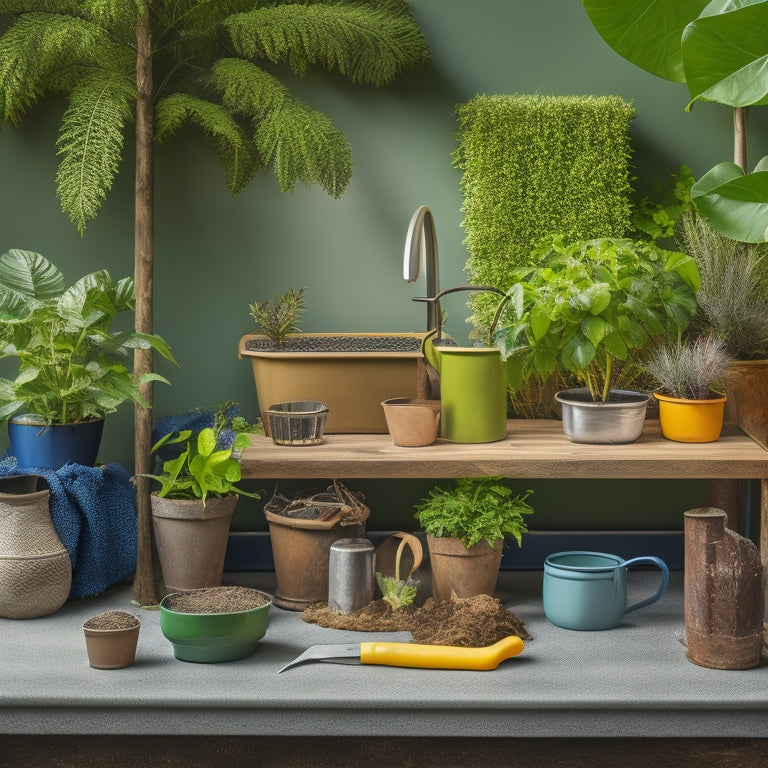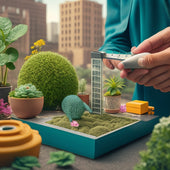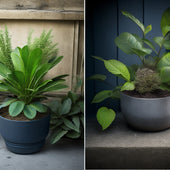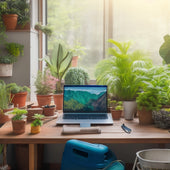
Top 5 Tools for Planters Beginners to Get Started
Share
You'll need a solid foundation of essential tools to successfully start and maintain your planter garden. Begin with a durable garden fork for efficient soil turning, a precision trowel for accurate seed and seedling placement, and a soil test kit to analyze pH and nutrient levels. Add a moisture sensor and drip irrigation system for optimized watering, and a pair of high-quality pruning shears for clean pruning cuts. Rounding out your top 5, a precision tape measure will come in handy for accurate measurements and layouts. With these tools in hand, you'll be well-equipped to tackle the nuances of planters gardening and achieve success in your new venture.
Key Takeaways
• Start with a durable garden fork for efficient soil turning and loosening without harming roots.
• Invest in a precision trowel for accurate seed and seedling planting at the correct depth.
• Get a soil test kit to analyze pH, NPK levels, and nutrient availability for informed gardening decisions.
• Use a moisture sensor to monitor soil moisture levels and prevent overwatering.
• Invest in a good pair of pruning shears for clean cuts and promoting healthy plant growth.
Essential Digging and Planting Tools
You'll need a few fundamental tools to break into the world of planters, starting with a sturdy garden fork for efficiently turning over soil and a trowel for scooping and placing plants with precision.
These essential digging and planting tools will become your trusted companions as you explore the world of sustainable gardening.
When it comes to planting techniques, having the right tools can make all the difference. A garden fork, for instance, allows you to gently loosen the soil without damaging the roots of nearby plants. This is especially important when working with delicate plants or in areas with compacted soil.
A trowel, on the other hand, provides the precision you need to plant seeds or seedlings at the correct depth. Look for one with a sturdy handle and a rust-resistant blade to guarantee it lasts through multiple planting seasons.
With these tools in your arsenal, you'll be well on your way to mastering the art of sustainable gardening and enjoying a bountiful harvest.
Soil Preparation and Mixing Tools
Dig in with a set of soil preparation and mixing tools that help you tailor your soil's composition to your plants' specific needs, ensuring a strong foundation for healthy growth. As a beginner planter, you'll want to invest in tools that allow you to test and adjust your soil's pH levels, nutrient content, and structure.
| Tool | Function | Benefit |
|---|---|---|
| Soil Test Kit | Analyze soil pH, NPK levels, and nutrient availability | Identify nutrient deficiencies and adjust fertilizer applications |
| Compost Turner | Mix and aerate compost piles | Speed up decomposition and create rich, nutrient-dense compost |
| Soil Rake | Break up clods, remove debris, and level soil | Create a smooth, even surface for planting |
| Soil Mixer | Blend soil amendments, fertilizers, and compost | Create a uniform soil composition tailored to your plants' needs |
| Garden Fork | Loosen and turn over soil | Improve soil aeration and drainage |
Watering and Irrigation Essentials
Your plants' watering needs are as unique as their soil requirements, and having the right tools for the task guarantees they receive the perfect amount of hydration for ideal growth. To guarantee precise watering, you'll need a reliable moisture sensor that monitors the soil's moisture levels, alerting you when it's time to water. This eliminates overwatering, which can be detrimental to your plants' health.
For efficient watering, consider investing in a drip irrigation system. This method delivers water directly to the roots, reducing evaporation and runoff. You can also customize the system to cater to different plant species, guaranteeing each plant receives the right amount of water.
When choosing a drip irrigation system, look for one with adjustable flow rates and emitters spaced according to your plants' needs. Additionally, consider a system with built-in filters to prevent clogging. By combining a moisture sensor with a drip irrigation system, you'll have complete control over your plants' watering needs, giving them the best chance to thrive.
Pruning and Training Equipment
As you nurture your plants, pruning and training become essential practices to maintain their health, promote bushy growth, and encourage blooming.
To master these techniques, you'll need the right equipment. Here are the must-haves for your pruning and training arsenal:
-
Pruning shears: Invest in high-quality, sharp pruning shears that can cut through stems with ease. This will help prevent crushing or tearing, which can lead to disease and pests.
-
Training stakes: These will help support and guide your plants as they grow. Look for stakes made from durable materials that won't harm your plants.
-
Garden twine or clips: Use these to tie up stems or attach them to training stakes. This will keep your plants upright and promote healthy growth.
- Pruning saw or loppers: For thicker branches, you'll need a pruning saw or loppers to make clean cuts. These tools will help you tackle more extensive pruning tasks with ease.
With these tools in your arsenal, you'll be well-equipped to prune and train your plants like a pro.
Remember to always prune with precision and care, as this will have a significant impact on your plant's overall health and appearance.
Measuring and Leveling Devices
Accurate measurements and leveling are essential in planters, and you'll need reliable tools to guarantee your planters are properly aligned and spaced. To achieve this, you'll require a combination of measuring and leveling devices that provide high measuring accuracy.
A good starting point is a precision tape measure or a digital caliper, which will allow you to take precise measurements of your planters, soil, and plants. For leveling, you'll need a spirit level or a laser level, which will enable you to verify your planters are perfectly horizontal or vertical. These tools will help you master various leveling techniques, such as checking for uneven ground or confirming your planters are at the same height.
When selecting measuring and leveling devices, look for products that offer high accuracy, durability, and ease of use. Consider devices with advanced features like Bluetooth connectivity or smartphone apps that can help you record and track your measurements.
Frequently Asked Questions
How Often Should I Water My Plants During the First Week?
When it comes to watering your new plants, you'll want to establish a consistent watering schedule during the first week.
Check the soil moisture levels daily, and water only when the top 1-2 inches feel dry to the touch. Overwatering is common, so start with once a day and adjust as needed.
You'll be monitoring for signs of stress, like wilting or yellowing leaves. By keeping a close eye on moisture levels, you'll guarantee your plants receive just the right amount of hydration.
What Is the Ideal Temperature for Seed Germination?
'When it rains, it pours,' and in this case, knowledge about seed germination is pouring in!
You're on the right track, focusing on ideal germination conditions. For most seeds, the perfect temperature for germination ranges from 65°F to 75°F (18°C to 24°C). This sweet spot sparks the metabolic process, allowing seeds to break dormancy.
Mastering seed germination techniques requires precision, so keep an eye on temperature, moisture, and light to guarantee successful sprouting.
Can I Use Regular Potting Soil for Indoor Plants?
When it comes to indoor plant care, you'll want to choose a potting soil that's specifically designed for indoor plants.
Regular potting soil can retain too much water, leading to root rot and poor drainage.
Look for potting soil types that are labeled as 'indoor' or 'houseplant' formulas, which are typically blended to provide better aeration and moisture control.
How Much Sunlight Do Plants Need to Thrive Indoors?
You think you can just plop a plant anywhere and expect it to thrive? Think again! Most plants need a whopping 4-6 hours of direct sunlight daily to reach their full potential indoors.
But here's the catch: not all indoor lighting is created equal. You'll need to strategically place your plants near south-facing windows or invest in grow lights to mimic natural outdoor conditions.
Proper plant placement is key, so don't be afraid to experiment and find the perfect spot for your green friends.
Should I Fertilize My Plants During the Winter Season?
When it comes to winter plant care, you're right to wonder if fertilizing is necessary. During the winter season, your plants' growth slows, and their nutrient requirements decrease.
You don't need to fertilize as frequently, but you shouldn't stop altogether. Instead, reduce the frequency and amount of fertilizer you use.
A balanced, water-soluble fertilizer applied at half the recommended strength will suffice. This will provide your plants with the necessary nutrients to survive the winter months without promoting excessive growth.
Conclusion
You've got your top 5 tools for planters beginners, but you might be thinking, 'I'm not sure I can afford all of these!'
Don't worry, you don't need to break the bank. Start with the essentials and gradually add more tools to your collection as you gain experience and confidence in your planting skills.
Remember, investing in quality tools will pay off in the long run with healthier plants and a more enjoyable planting experience.
Happy planting!
Related Posts
-

10 Essential Tips for Sizing Block Planters Perfectly
When sizing block planters, you need to take into account multiple factors to get it just right. Measure your cinder ...
-

10 Essential Tips for Sizing Block Planters Perfectly
When sizing block planters, you need to take into account multiple factors to get it just right. Measure your cinder ...
-

10 Essential Tips for Sizing Block Planters Perfectly
When sizing block planters, you need to take into account multiple factors to get it just right. Measure your cinder ...
-

10 Essential Tips for Sizing Block Planters Perfectly
When sizing block planters, you need to take into account multiple factors to get it just right. Measure your cinder ...
-

10 Essential Tips for Sizing Block Planters Perfectly
When sizing block planters, you need to take into account multiple factors to get it just right. Measure your cinder ...
-

10 Essential Tips for Sizing Block Planters Perfectly
When sizing block planters, you need to take into account multiple factors to get it just right. Measure your cinder ...
-

10 Essential Tips for Sizing Block Planters Perfectly
When sizing block planters, you need to take into account multiple factors to get it just right. Measure your cinder ...
-

10 Essential Tips for Sizing Block Planters Perfectly
When sizing block planters, you need to take into account multiple factors to get it just right. Measure your cinder ...
-

10 Essential Tips for Sizing Block Planters Perfectly
When sizing block planters, you need to take into account multiple factors to get it just right. Measure your cinder ...
-

10 Essential Tips for Sizing Block Planters Perfectly
When sizing block planters, you need to take into account multiple factors to get it just right. Measure your cinder ...
-

10 Essential Tips for Sizing Block Planters Perfectly
When sizing block planters, you need to take into account multiple factors to get it just right. Measure your cinder ...
-

10 Essential Tips for Sizing Block Planters Perfectly
When sizing block planters, you need to take into account multiple factors to get it just right. Measure your cinder ...
-

10 Essential Tips for Sizing Block Planters Perfectly
When sizing block planters, you need to take into account multiple factors to get it just right. Measure your cinder ...
-

10 Essential Tips for Sizing Block Planters Perfectly
When sizing block planters, you need to take into account multiple factors to get it just right. Measure your cinder ...
-

10 Essential Tips for Sizing Block Planters Perfectly
When sizing block planters, you need to take into account multiple factors to get it just right. Measure your cinder ...
-

10 Essential Tips for Sizing Block Planters Perfectly
When sizing block planters, you need to take into account multiple factors to get it just right. Measure your cinder ...
-

10 Essential Tips for Sizing Block Planters Perfectly
When sizing block planters, you need to take into account multiple factors to get it just right. Measure your cinder ...
-

10 Essential Tips for Sizing Block Planters Perfectly
When sizing block planters, you need to take into account multiple factors to get it just right. Measure your cinder ...
-

10 Essential Tips for Sizing Block Planters Perfectly
When sizing block planters, you need to take into account multiple factors to get it just right. Measure your cinder ...
-

10 Essential Tips for Sizing Block Planters Perfectly
When sizing block planters, you need to take into account multiple factors to get it just right. Measure your cinder ...
-

10 Essential Tips for Sizing Block Planters Perfectly
When sizing block planters, you need to take into account multiple factors to get it just right. Measure your cinder ...
-

10 Essential Tips for Sizing Block Planters Perfectly
When sizing block planters, you need to take into account multiple factors to get it just right. Measure your cinder ...
-

10 Essential Tips for Sizing Block Planters Perfectly
When sizing block planters, you need to take into account multiple factors to get it just right. Measure your cinder ...
-

10 Essential Tips for Sizing Block Planters Perfectly
When sizing block planters, you need to take into account multiple factors to get it just right. Measure your cinder ...
-

10 Essential Tips for Sizing Block Planters Perfectly
When sizing block planters, you need to take into account multiple factors to get it just right. Measure your cinder ...
-

10 Essential Tips for Sizing Block Planters Perfectly
When sizing block planters, you need to take into account multiple factors to get it just right. Measure your cinder ...
-

10 Essential Tips for Sizing Block Planters Perfectly
When sizing block planters, you need to take into account multiple factors to get it just right. Measure your cinder ...
-

10 Essential Tips for Sizing Block Planters Perfectly
When sizing block planters, you need to take into account multiple factors to get it just right. Measure your cinder ...
-

10 Essential Tips for Sizing Block Planters Perfectly
When sizing block planters, you need to take into account multiple factors to get it just right. Measure your cinder ...
-

10 Essential Tips for Sizing Block Planters Perfectly
When sizing block planters, you need to take into account multiple factors to get it just right. Measure your cinder ...
-

10 Essential Tips for Sizing Block Planters Perfectly
When sizing block planters, you need to take into account multiple factors to get it just right. Measure your cinder ...
-

10 Essential Tips for Sizing Block Planters Perfectly
When sizing block planters, you need to take into account multiple factors to get it just right. Measure your cinder ...
-

10 Essential Tips for Sizing Block Planters Perfectly
When sizing block planters, you need to take into account multiple factors to get it just right. Measure your cinder ...
-

10 Essential Tips for Sizing Block Planters Perfectly
When sizing block planters, you need to take into account multiple factors to get it just right. Measure your cinder ...
-

10 Essential Tips for Sizing Block Planters Perfectly
When sizing block planters, you need to take into account multiple factors to get it just right. Measure your cinder ...
-

10 Essential Tips for Sizing Block Planters Perfectly
When sizing block planters, you need to take into account multiple factors to get it just right. Measure your cinder ...
-

10 Essential Tips for Sizing Block Planters Perfectly
When sizing block planters, you need to take into account multiple factors to get it just right. Measure your cinder ...
-

10 Essential Tips for Sizing Block Planters Perfectly
When sizing block planters, you need to take into account multiple factors to get it just right. Measure your cinder ...
-

What's the Ideal Timeline for a Concrete Planter Reno
You'll need to allocate around 6-12 weeks for a concrete planter renovation, broken down into seven distinct phases t...
-

What's the Ideal Timeline for a Concrete Planter Reno
You'll need to allocate around 6-12 weeks for a concrete planter renovation, broken down into seven distinct phases t...
-

What's the Ideal Timeline for a Concrete Planter Reno
You'll need to allocate around 6-12 weeks for a concrete planter renovation, broken down into seven distinct phases t...
-

What's the Ideal Timeline for a Concrete Planter Reno
You'll need to allocate around 6-12 weeks for a concrete planter renovation, broken down into seven distinct phases t...
-

What's the Ideal Timeline for a Concrete Planter Reno
You'll need to allocate around 6-12 weeks for a concrete planter renovation, broken down into seven distinct phases t...
-

What's the Ideal Timeline for a Concrete Planter Reno
You'll need to allocate around 6-12 weeks for a concrete planter renovation, broken down into seven distinct phases t...
-

What's the Ideal Timeline for a Concrete Planter Reno
You'll need to allocate around 6-12 weeks for a concrete planter renovation, broken down into seven distinct phases t...
-

What's the Ideal Timeline for a Concrete Planter Reno
You'll need to allocate around 6-12 weeks for a concrete planter renovation, broken down into seven distinct phases t...
-

What's the Ideal Timeline for a Concrete Planter Reno
You'll need to allocate around 6-12 weeks for a concrete planter renovation, broken down into seven distinct phases t...
-

What's the Ideal Timeline for a Concrete Planter Reno
You'll need to allocate around 6-12 weeks for a concrete planter renovation, broken down into seven distinct phases t...
-

What's the Ideal Timeline for a Concrete Planter Reno
You'll need to allocate around 6-12 weeks for a concrete planter renovation, broken down into seven distinct phases t...
-

What's the Ideal Timeline for a Concrete Planter Reno
You'll need to allocate around 6-12 weeks for a concrete planter renovation, broken down into seven distinct phases t...
-

What's the Ideal Timeline for a Concrete Planter Reno
You'll need to allocate around 6-12 weeks for a concrete planter renovation, broken down into seven distinct phases t...
-

What's the Ideal Timeline for a Concrete Planter Reno
You'll need to allocate around 6-12 weeks for a concrete planter renovation, broken down into seven distinct phases t...
-

What's the Ideal Timeline for a Concrete Planter Reno
You'll need to allocate around 6-12 weeks for a concrete planter renovation, broken down into seven distinct phases t...
-

What's the Ideal Timeline for a Concrete Planter Reno
You'll need to allocate around 6-12 weeks for a concrete planter renovation, broken down into seven distinct phases t...
-

What's the Ideal Timeline for a Concrete Planter Reno
You'll need to allocate around 6-12 weeks for a concrete planter renovation, broken down into seven distinct phases t...
-

What's the Ideal Timeline for a Concrete Planter Reno
You'll need to allocate around 6-12 weeks for a concrete planter renovation, broken down into seven distinct phases t...
-

What's the Ideal Timeline for a Concrete Planter Reno
You'll need to allocate around 6-12 weeks for a concrete planter renovation, broken down into seven distinct phases t...
-

What's the Ideal Timeline for a Concrete Planter Reno
You'll need to allocate around 6-12 weeks for a concrete planter renovation, broken down into seven distinct phases t...
-

What's the Ideal Timeline for a Concrete Planter Reno
You'll need to allocate around 6-12 weeks for a concrete planter renovation, broken down into seven distinct phases t...
-

Must-Have Tools for Building Block Planters Online
When building block planters online, you'll need essential tools to guarantee a sturdy and visually appealing structu...
-

Must-Have Tools for Building Block Planters Online
When building block planters online, you'll need essential tools to guarantee a sturdy and visually appealing structu...
-

Must-Have Tools for Building Block Planters Online
When building block planters online, you'll need essential tools to guarantee a sturdy and visually appealing structu...
-

Must-Have Tools for Building Block Planters Online
When building block planters online, you'll need essential tools to guarantee a sturdy and visually appealing structu...
-

Must-Have Tools for Building Block Planters Online
When building block planters online, you'll need essential tools to guarantee a sturdy and visually appealing structu...
-

Must-Have Tools for Building Block Planters Online
When building block planters online, you'll need essential tools to guarantee a sturdy and visually appealing structu...
-

Must-Have Tools for Building Block Planters Online
When building block planters online, you'll need essential tools to guarantee a sturdy and visually appealing structu...
-

Must-Have Tools for Building Block Planters Online
When building block planters online, you'll need essential tools to guarantee a sturdy and visually appealing structu...
-

Must-Have Tools for Building Block Planters Online
When building block planters online, you'll need essential tools to guarantee a sturdy and visually appealing structu...
-

Must-Have Tools for Building Block Planters Online
When building block planters online, you'll need essential tools to guarantee a sturdy and visually appealing structu...
-

Must-Have Tools for Building Block Planters Online
When building block planters online, you'll need essential tools to guarantee a sturdy and visually appealing structu...
-

Must-Have Tools for Building Block Planters Online
When building block planters online, you'll need essential tools to guarantee a sturdy and visually appealing structu...
-

Must-Have Tools for Building Block Planters Online
When building block planters online, you'll need essential tools to guarantee a sturdy and visually appealing structu...
-

Must-Have Tools for Building Block Planters Online
When building block planters online, you'll need essential tools to guarantee a sturdy and visually appealing structu...
-

Must-Have Tools for Building Block Planters Online
When building block planters online, you'll need essential tools to guarantee a sturdy and visually appealing structu...
-

Must-Have Tools for Building Block Planters Online
When building block planters online, you'll need essential tools to guarantee a sturdy and visually appealing structu...
-

Must-Have Tools for Building Block Planters Online
When building block planters online, you'll need essential tools to guarantee a sturdy and visually appealing structu...
-

Must-Have Tools for Building Block Planters Online
When building block planters online, you'll need essential tools to guarantee a sturdy and visually appealing structu...
-

Must-Have Tools for Building Block Planters Online
When building block planters online, you'll need essential tools to guarantee a sturdy and visually appealing structu...
-

Must-Have Tools for Building Block Planters Online
When building block planters online, you'll need essential tools to guarantee a sturdy and visually appealing structu...
-

Must-Have Tools for Building Block Planters Online
When building block planters online, you'll need essential tools to guarantee a sturdy and visually appealing structu...
-

Must-Have Tools for Building Block Planters Online
When building block planters online, you'll need essential tools to guarantee a sturdy and visually appealing structu...
-

Must-Have Tools for Building Block Planters Online
When building block planters online, you'll need essential tools to guarantee a sturdy and visually appealing structu...


